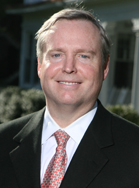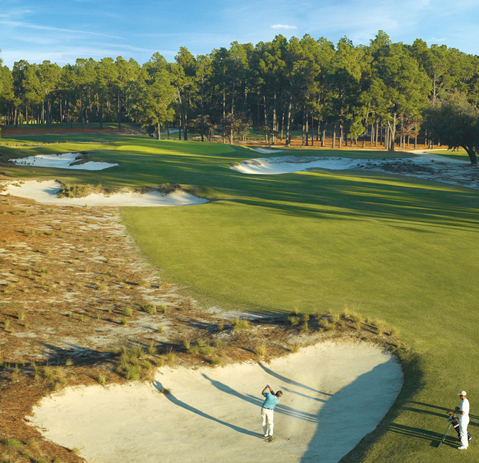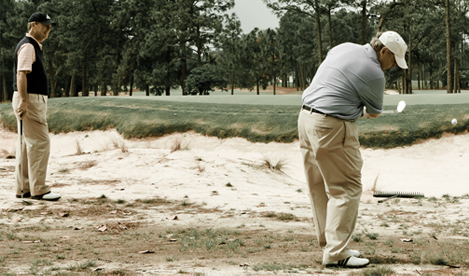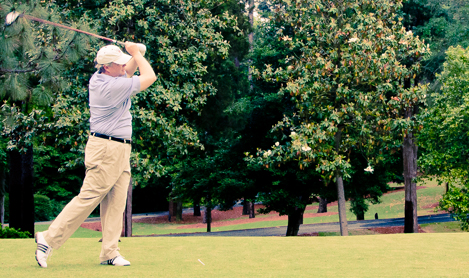© 2013 The Texas Lawbook.
By Patricia Baldwin
Lifestyle Writer for The Texas Lawbook
(June 3) – Longtime Dallas businessman Bob Dedman is known for his thoughtful and deliberate decision-making. Yet, when presented with one of the most important deals of his career, he took fewer than five minutes. He said “yes” to the U.S. Golf Association’s proposal to hold the U.S. Open and the U.S. Women’s Open championships during back-to-back weeks in June 2014 at Pinehurst, the fabled North Carolina resort owned by the Dedman family.

The back-story, however, takes a bit longer to tell. It involves historical research, a golf legacy, a few colorful characters, a billionaire’s vision and even Mother Nature – not necessarily in that order.
And the tale is just part of the unfolding journey of Dedman’s business transition since the 2006 sale of ClubCorp, the Dallas-based company his late father, Robert, founded in 1957, the year the younger Dedman was born. Following his father’s death in 2002, Dedman added “chairman” to his CEO title of the company that touted itself as the world’s largest owner and operator of private golf and business clubs, country clubs, and resorts.
Once the overseer of an endeavor with 18,000 employees worldwide, Dedman now guides a downsized and reshaped “family office,” DFI Management Ltd. He says he typically spends a third of his business day on Pinehurst, a third on investments and a third on charitable foundations.
More than ever, he says he uses the skills gained from his JD degree earned at Southern Methodist University – before his family’s philanthropy changed the law school’s name to Dedman School of Law. Not surprisingly, given the family ties and ongoing philanthropy, Dedman is a member of the 18-strong search committee charged with hiring a new law school dean and chaired by SMU Cox Business School Dean Albert Niemi Jr.
President of Pinehurst Don Padgett has observed Dedman’s use of his lawyering skills.
“Bob has gotten more accustomed to making an educated guess than grinding out the last detail,” he says. “There is no corporate headquarters. We’re more nimble. We have to be more flexible in decision-making.”
Padgett was on the other end of the 2009 telephone call with Dedman that clinched the doubleheader of Opens.
Padgett remembers that, when he told Dedman about the USGA’s “interesting” proposal, there was a proverbial “pregnant” pause.
Then Dedman asked, “Has it ever been done before?”
Padgett responded, “No. It would be pretty historic.”
Dedman said, “Tell them we’re in.”
Padgett says the brief conversation “spoke volumes” about Dedman’s commitment to working with the USGA and his confidence in the ongoing support of the North Carolina business community.
The U.S. Open already was scheduled to return to the Pinehurst No. 2 golf course in 2014 for the third time in 15 years. [Golfers will remember Pinehurst’s first U.S. Open in June 1999, when Payne Stewart, the only player to finish under par, won his second Open title on the 72nd hole by one stroke over Phil Mickelson. Stewart, 42, died in an airplane accident the following October. In 2005, New Zealand golfer Michael Campbell held off a charging Tiger Woods to win his first career major by two shots.]
For the 1999 championship, North Carolina banker Jim Hyler organized the President’s Council of statewide business leaders to help sell corporate hospitality. So many companies supported the event that Pinehurst had a waiting list. Hyler later served as president of the USGA, and the successful sales model for Pinehurst’s championships continues under the leadership of Charlotte businessman Mac Everett. [Tickets for 2014 will go on sale for the general public on June 10, the first day of this year’s U.S. Open at Merion Golf Club in Ardmore, Pa.]

Photo by John Gessner
Reflecting upon his decision, Dedman muses, “This will either be the best thing we’ve ever done or the worst thing. So far, the returns look great.”
“This,” Dedman notes, actually included tandem decisions. “There are two separate stories.”
One story, of course, is about the back-to-back championships. Former USGA executive director David Fay devised the idea of the successive Opens, hoping, among other things, to save time and money. After all, tents will be set-up for corporate hospitality, concessions and the media. Ropes will line the fairways; grandstands, scoreboards and television towers will be in place.
But also, Fay told Sports Illustrated, he envisioned the historic decision to create a needed buzz for women’s golf. In fact, he suggested that, since the U.S. Open is not restricted to male players, it would be possible for someone to qualify for both championships.
The second story, which is just as important to Dedman, is about the restoration of the Pinehurst No. 2 golf course to much of its original design by famed golf architect Donald Ross. The course first opened in 1907 and was completed in its final routing in 1935.

features grass only on the fairways and greens.
Chip Henderson Photography
Yet, over the years, the golf course became a “sea of green,” Dedman relates. “We felt we had lost something in modern technology’s triumph over Mother Nature. Just because you could have wall-to-wall irrigation didn’t mean you should have it.”
Dedman uses the term “the homogenization of golf,” adding, “I don’t think that’s what Ross intended.”
The question he asked: “How do we restore the character of the course and the spirit of Ross?”
He looked for the answer from the Austin-based Coore & Crenshaw golf architectural firm. The partners – two-time Masters champ Ben Crenshaw and native North Carolinian Bill Coore – turned to Ross’ original drawings and military aerial photographs taken during World War II.
The yearlong, $2.5 million restoration began in 2010. The most noticeable transformation came with the elimination of rough, leaving only two cuts of grass – fairway and green. Hardpan, sand, pinestraw and wire grass replaced some 32 acres of grass.
The change is more environmentally and economically sustainable, Dedman says, noting that 700 of the 1,100 sprinkler heads were removed.
“Golf doesn’t build character; it reveals character,” Dedman says, adding that the restored No. 2 still offers substantial challenges. “Play involves an element of luck now.”
For example, the Coore & Crenshaw team did not touch Ross’ famed dome-shaped, “turtleback” greens. And the ball is more likely to run off the firm and fast fairways, which can give golfers a great lie – or not, depending upon where the ball lands.
In their reporting, the golf media often have used the words “bold” and “risk” in describing the venture.
Bradley Klein, architecture editor of Golfweek, calls the scheduling of the back-to-back Opens “a bold move that will cement Pinehurst’s position at the core of the American golf world.”
Klein, also the author of the book “Discovering Donald Ross,” notes the move comes with some risks, which have to do with “everything from potential rain delays, impact on the off-fairway areas and crossing paths after the first week of play – and whether the landing areas for the women can be calibrated to be outside of the areas subject to divoting from the men.”
Freelancer Lee Pace has been writing about North Carolina golf for more than 25 years. “The Golden Age of Pinehurst,” his fourth book documenting the story of the resort, reflects his belief the risk already has been rewarded.
“What strikes me about this restoration project was the incredible vision and fortitude it took on the part of everyone involved – the vision to see what a golf course could look like if you dialed back the clock 75 years and the guts to move ahead with it,” Pace comments. “Bob Dedman and Don Padgett had the nerve to pull trigger on this, and Bill Coore and Ben Crenshaw had the perfect perspective and touch to execute it.”
Dedman also knows that 2014 will come and go. His vision of the “golden age” of Pinehurst is the future. He’d like golfers and non-golfers to equate Pinehurst with a “way of life – a southern ideal.”

plays from the rough on Pinehurst No. 2.
Photo by John Gessner
He says there is no current plan to start development on a long-rumored No. 9 golf course to be added to Pinehurst’s eight existing courses. The fact remains, however, that the Dedman family controls 925 contiguous acres of property in nearby Aberdeen, N.C., from real estate acquisitions, including the 2011 purchase of the Pit Golf Links.
Dedman notes, however, a $3.7 million renovation of the Member Clubhouse will be completed in June. And last year, a new short-game practice area was constructed at Pinehurst.
He points out that, more than any other ClubCorp property, his father saw Pinehurst as his legacy. In 1984, the self-made billionaire acquired the resort, which was in a state of disrepair. The elder Dedman once told a reporter that he got tears in his eyes the first time he stood in front of the clubhouse. After $100 million in renovations, Robert Dedman began calling Pinehurst the “St. Andrews of the New World,” comparing the North Carolina resort with the historic Scottish home of golf. The marketing message was bolstered by the fact that, in summer 2005, as Pinehurst No. 2 provided the venue for the U.S. Open, the St. Andrews Old Course was the site of the British Open.
The 2005 championship at Pinehurst had a record attendance of 325,000 people, about 100,000 more than last year’s Open at the Olympic Club in San Francisco. With Mother Nature’s cooperation, the USGA is projecting 400,000 attendees or more for the two 2014 championships.
Pinehurst’s Padgett foresees the span of championships as a “two-week celebration of golf.” He notes that the back-to-back Opens provide a “little nod” to the way the sport of tennis conducts its men’s and women’s championships at the same time.

Photo by John Gessner
“There are so many sidebars,” he adds, referring to the numerous stories surrounding the historic decision.
Dedman recalls his father’s penchant for saying he was in the business of “selling fun.” He cites that philosophy as a reason for the family’s retaining ownership of Pinehurst when the private equity firm KSL Capital Partners acquired ClubCorp. Equally important reasons, Dedman adds, were the resort’s historical significance and financial stability.
He says he has had a “deep learning curve” in the reshaped family business. “I have to be a generalist, which is why law school prepared me.” From one day to the next, he says he might need to deal with issues of taxation, real estate, contracts, estate law, torts and other areas. Law school, he adds, taught him ways to think about how to solve problems.
Dedman is committed to continuing his father’s extensive philanthropic efforts to support the arts, medicine and higher education and says the family does not want to be known for “check-book philanthropy.” They want to be involved. Family members have managed both, with personal and financial contributions too numerous to list.
For example, Dedman serves as a trustee of SMU, University of Texas Southwestern Medical Foundation, Dallas Museum of Art, the Hockaday School and Dallas Medical Resource. He also serves as a member of the board of the SMU Dedman School of Law, SMU Dedman College, vice chairman of the O’Donnell Foundation, Advanced Placement Strategies and the UT Austin Development Board. He is a member of the USGA President’s Council and past chairman of the Texas Business Hall of Fame.
In 2008, the Dedman Foundation pledged a landmark $12 million to the Southwestern Medical Foundation to establish and sustain the Dedman Family Endowed Program for Scholars in Clinical Care at UT Southwestern Medical Center.
This March, the Dedman Foundation and Nancy Dedman, the elder Dedman’s widow, added $5 million to the endowment for the Dedman Distinguished Scholars Program at UT Austin. There are currently 13 Dedman Scholars annually. The new funding will allow for an increase of at least six scholarships for fall 2013 and will build up to 25 scholarships during the next four years.
As for the family’s ongoing support of SMU, Dedman points out, “We’re all alums.” In particular, he says family members care about the law school’s impact on the Dallas community.
He describes the search committee for the SMU law dean as “diverse.” And while it is early in the search process, he comments, “The fundamental challenge is how to capture the opportunities and the challenges of the evolving 21st century.”
Dedman acknowledges that his life has more balance – post-ClubCorp – and that he spends more time with his wife, Rachael, and their 10-year-old and 12-year-old daughters.
He says he still loves the game of golf and carries a handicap index between six and eight. “I can’t play to that,” he adds, attributing the disparity to the “aging process.” He laughs when reminded what his father – prone to sprinkling his speech with homespun, sometimes saucy, truisms – liked to say about being in the golf business.
Dedman repeats his father’s words: “If you have a handicap over 20, you have no business being in the business. If you have a handicap under five, you have no business.”
What does he miss most about his ClubCorp years? “The people,” he answers quickly. “The shared values.” And, he admits, he still relies on many of his father’s maxims and philosophies.
He then recites a quote attributed to Mark Twain: “When I was a boy of 14, my father was so ignorant I could hardly stand to have the old man around. But when I got to be 21, I was astonished at how much he had learned in seven years.”
Do you have a special avocation, hobby or other lifestyle interest to share? Please email patricia.baldwin@texaslawbook.net.
© 2013 The Texas Lawbook. Content of The Texas Lawbook is controlled and protected by specific licensing agreements with our subscribers and under federal copyright laws. Any distribution of this content without the consent of The Texas Lawbook is prohibited.
If you see any inaccuracy in any article in The Texas Lawbook, please contact us. Our goal is content that is 100% true and accurate. Thank you.
